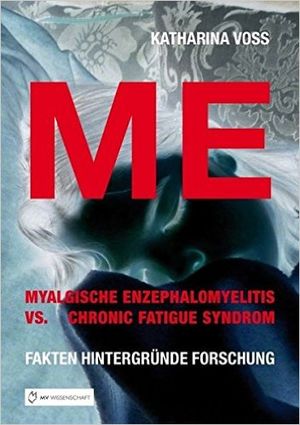ME - Myalgische Enzephalomyelitis vs. Chronic Fatigue Syndrom - Fakten Hintergründe Forschung
 | |
| Author | Katharina Voss |
|---|---|
| Country | Germany |
| Language | German |
| Genre | Medical |
| Publisher | tredition |
Publication date | 2017 |
| Media type | |
| Pages | 572 |
| ISBN | 978-3743924949 |
ME - Myalgische Enzephalomyelitis vs. Chronic Fatigue Syndrom - Fakten Hintergründe Forschung (ME - Myalgic Encephalomyelitis vs. Chronic Fatigue Syndrome – Facts, Background, Research) is a German book by Katharina Voss.
Publisher's synopsis[edit | edit source]
(This synopsis was provided by the publisher for promotional purposes. For book reviews, please see Links section below.)
A book about myalgic encephalomyelitis, also erroneously referred to as "Chronic Fatigue Syndrome" or "ME/CFS", and more recently also as "Systemic Exertion Intolerance Disease" or "SEID".
A book about the most common and devastating disease your doctor has never heard of.
A book about a disease which in the opinion of a large part of the medical profession does not exist, and which, according to many physicians, psychiatrists and psychosomatics, exists only in the minds of patients - although it was already classified as a neurological disease by the WHO more than 40 years ago! Severe physical and mental constraints cause cruel suffering among those affected. For many years or decades patients have to endure a quality of life comparable to that of end-stage AIDS and cancer patients - without being adequately supplied with medication.
In the first part of the book comprehensive information about the historical and medical facts about myalgic encephalomyelitis and the sometimes serious grievances in the treatment of patients are given. In the second part, the background is explained on the basis of well-documented facts, which have led to this disease becoming the orphan of our health care system and today is trivialized, psychopathologized or even denied. In the third part, a selection of interesting results from recent biomedical ME/"CFS" research will be presented.
The book is not only for doctors and all those employed in medical care, but also for patients, their relatives and the many patients who have not been diagnosed so far. They are given the necessary tools in order to defend themselves against misdiagnosis and falsehoods. Likewise their attorneys and legal representatives, so that they can get a picture of the current state of research.
Links[edit | edit source]
Learn more[edit | edit source]
- A Rezension Katharina Voss: ME - Myalgische Enzephalomyelitis vs. Chronic Fatigue Syndrom Fakten Hintergründe Forschung of Regina Clos
- Katharina Voss' blog
References[edit | edit source]

